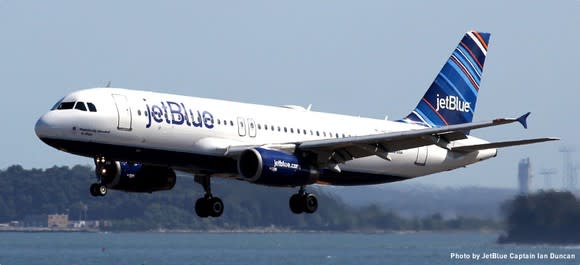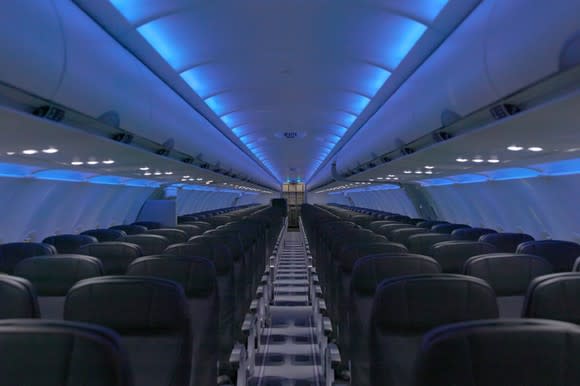Here's My Top Stock to Buy for 2018
After a big market rally in 2017, U.S. stocks look fairly expensive, on average. Among the few stocks that are still cheap, many are cheap for a very good reason: They aren't growing.
However, there are still a few stocks that offer an enticing combination of modest valuations and ample growth prospects. JetBlue Airways (NASDAQ: JBLU) definitely fits the bill. The stock trades for just 12 times JetBlue's estimated 2017 earnings. Meanwhile, the company has lots of opportunities to maintain its recent high-single-digit capacity growth rate -- while also expanding its margins. As a result, JetBlue Airways is my top stock pick for 2018.
Unit revenue is reaching an inflection point
Unit revenue trends have been one of the biggest drivers of airline stock performance in recent years. During the first nine months of 2017, JetBlue's revenue per available seat mile (RASM) rose a paltry 1.1% year over year. Furthermore, in late October, the company projected that RASM would move in a range from unchanged to down 3% in the fourth quarter.
However, like many other airlines, JetBlue significantly increased its Q4 unit revenue guidance last month. It now expects RASM to come in between down 0.5% and up 1.5% for the quarter.

JetBlue's unit revenue trends have been improving recently. Image source: JetBlue Airways.
This outlook bodes well heading into the first quarter. First, the fare pressure that JetBlue was seeing a few months ago seems to be fading. (Rising fuel prices may be forcing airlines to be more disciplined about pricing.) Second, JetBlue will face much easier year-over-year comparisons in the first quarter, as RASM plunged 4.8% year over year in Q1 2017, compared with a more modest 1.5% decline in Q4 2016.
Mint will boost JetBlue's revenue momentum
The growth of JetBlue's highly acclaimed Mint premium service will add to the carrier's 2018 RASM momentum. JetBlue has found that introducing Mint on a new transcontinental route typically drives a strong double-digit RASM increase.
In 2017, JetBlue expanded its fleet of Mint-equipped A321s from 17 aircraft to 31. However, this growth was backloaded. In fact, five of those 14 Mint deliveries came in November and December. As a result, this expansion of the Mint fleet will have most of its impact during 2018.

JetBlue is expanding its Mint premium service rapidly. Image source: JetBlue Airways.
For example, JetBlue upgraded its Boston-San Diego route to Mint service in mid-December, so there was very little RASM impact on the fourth quarter. Last week, it upgraded to Mint on the Boston-Las Vegas route, and it will add more Mint flights on the New York-Los Angeles and Boston-San Francisco routes later this month. Boston-Seattle will get Mint flights in mid-February, followed by New York-Seattle in mid-April.
Thus, there will be a big increase in Mint flights this quarter relative to Q4 -- and an even bigger increase year over year. This situation will support stronger RASM growth.
The accelerated Mint rollout is coming at the perfect time. JetBlue originally decided to expand Mint more broadly after losing a bidding war for Virgin America to Alaska Air (NYSE: ALK). The goal was to challenge Alaska Air's West Coast dominance with upgraded service on transcontinental routes. Alaska Air has hit a rough patch lately, which could affect customer loyalty. The disappearance of the Virgin America brand this spring could cause more customers to defect. Thus, JetBlue has a unique opportunity to gain high-value customers in Alaska Air's key markets during 2018.
Can JetBlue overcome its cost headwinds?
It will be particularly important for JetBlue to accelerate its RASM growth during 2018, because it's likely to face a steep increase in fuel costs. The market price of Gulf Coast jet fuel reached $1.90 per gallon recently. At that level, JetBlue's average fuel price for 2018 would be up as much as $0.40 per gallon year over year. That would represent a roughly 4-percentage-point margin headwind.
Between its growing revenue momentum, relatively easy year-over-year comparisons, and the benefit of its Mint expansion, JetBlue should be able to offset this level of cost inflation. But it will still need to keep non-fuel unit costs in check.
If JetBlue completes a contract deal with its pilots this year, that could drive a substantial uptick in costs. Nevertheless, management has stated repeatedly that non-fuel unit costs will rise no more than 1% annually (on average) from 2018 to 2020.
On the favorable side of the ledger, hurricanes Irma and Maria drove up unit costs by about 1.5 percentage points in 2017. An abnormal number of delays from runway closures in New York and Boston also pushed non-fuel costs higher last year, as did a decrease in JetBlue's average stage length (the distance covered by each flight). All three factors will contribute to easy year-over-year comparisons for non-fuel unit costs. Furthermore, JetBlue should start to reap significant savings from its $250 million-$300 million structural cost reduction program in 2018.

JetBlue faced some severe one-time cost headwinds in 2017. Image source: JetBlue Airways.
Depending on the timing of a pilot contract deal, JetBlue's non-fuel unit costs could potentially rise more than 1% this year. However, the carrier should be able to offset most of that increase with unit cost declines in the following years. And until a pilot deal is agreed to, JetBlue's non-fuel unit costs are likely to be down year over year, on average.
Tax reform and share buybacks will provide an extra boost
A combination of strong unit revenue growth and better non-fuel cost performance will be the two biggest catalysts for JetBlue stock this year. However, the company will also get a big boost from tax reform.
In recent years, JetBlue's effective tax rate has been 37%-38%. The recent reduction of the federal corporate tax rate from 35% to 21% should slash JetBlue's effective tax rate by 14 percentage points. This change will boost its after-tax earnings by roughly 22%.
Furthermore, the new law will let companies immediately deduct the cost of capital spending from their taxable income for the next five years. As a result, JetBlue's cash tax rate will decline even more than its book tax rate, causing free cash flow to soar in 2018.
Last month, JetBlue's board authorized a two-year, $750 million share-repurchase program. Based on JetBlue's recent stock price, that would be enough to retire 11% of its shares. Thanks to the windfall from tax reform, the company should be able to complete most of this buyback program in 2018.
Beyond 2018, JetBlue has ample opportunities to continue growing, particularly if it decides to enter the trans-Atlantic market with the extended-range A321LR aircraft. It will also capture more savings from its structural cost program and from a plan to add 12 seats to each of its A320s.
Thanks to the combination of higher revenue, a lower tax rate, and share repurchases, JetBlue's EPS could rise more than 40% in 2018, assuming its pre-tax margin stays flat year over year. On the flip side, even if the company faces modest margin pressure in 2018, it is still likely to post strong EPS growth. With the stock trading for just 12 times its projected 2017 earnings today, JetBlue Airways is my top stock pick for 2018.
More From The Motley Fool
Adam Levine-Weinberg owns shares of Alaska Air Group and JetBlue Airways and is long January 2019 $10 calls on JetBlue Airways. The Motley Fool recommends JetBlue Airways. The Motley Fool has a disclosure policy.

 Yahoo Finance
Yahoo Finance 